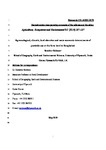Agroecological, climatic, land elevation and socio-economic determinants of pesticide use at the farm level in Bangladesh
| dc.contributor.author | Rahman, Sanzidur | |
| dc.date.accessioned | 2015-11-09T13:12:37Z | |
| dc.date.available | 2015-11-09T13:12:37Z | |
| dc.date.issued | 2015-12 | |
| dc.identifier.issn | 0167-8809 | |
| dc.identifier.issn | 1873-2305 | |
| dc.identifier.uri | http://hdl.handle.net/10026.1/3776 | |
| dc.description.abstract |
This study examines the influence of agroecology, climate, land elevation and socio-economic factors on pesticide use at the farm level using a large survey data of 2083 farms from 17 districts covering 10 agroecological zones in Bangladesh by applying a Tobit model. Overall, 75.4% of farmers used pesticides in any one crop. Within the pesticide users, pesticide use rate is highest in oilseed production estimated at BDT 2508.6ha−1 (3.74% of gross output value) followed by jute at BDT 1976.1ha−1 (1.88% of gross output value). Pesticide use is significantly lower in floodplain agroecologies, high rainfall areas, high land and low land elevation zones but significantly higher in medium high land elevation zone. Among the socio-economic factors, pulse area significantly reduces pesticide use whereas an increase in rice and pulse prices and organic manure application significantly increases it. Educated farmers and medium/large as well as small farms use significantly more pesticides. Policy implications include investments in developing crop varieties suitable for floodplain agroecologies, high rainfall, high land and low land elevation zones, expansion of pulse area and a reduction in fertilizer prices. | |
| dc.format.extent | 187-197 | |
| dc.format.medium | Undetermined | |
| dc.language | en | |
| dc.language.iso | en | |
| dc.publisher | Elsevier BV | |
| dc.subject | Pesticide use | |
| dc.subject | Multivariate Tobit analysis | |
| dc.subject | Agroecology | |
| dc.subject | Climate | |
| dc.subject | Land elevation | |
| dc.subject | Bangladesh | |
| dc.title | Agroecological, climatic, land elevation and socio-economic determinants of pesticide use at the farm level in Bangladesh | |
| dc.type | journal-article | |
| dc.type | Journal Article | |
| plymouth.author-url | https://www.webofscience.com/api/gateway?GWVersion=2&SrcApp=PARTNER_APP&SrcAuth=LinksAMR&KeyUT=WOS:000361261100019&DestLinkType=FullRecord&DestApp=ALL_WOS&UsrCustomerID=11bb513d99f797142bcfeffcc58ea008 | |
| plymouth.volume | 212 | |
| plymouth.publication-status | Published | |
| plymouth.journal | Agriculture, Ecosystems & Environment | |
| dc.identifier.doi | 10.1016/j.agee.2015.07.002 | |
| plymouth.organisational-group | /Plymouth | |
| plymouth.organisational-group | /Plymouth/Faculty of Arts, Humanities and Business | |
| plymouth.organisational-group | /Plymouth/Users by role | |
| dc.identifier.eissn | 1873-2305 | |
| dc.rights.embargoperiod | Not known | |
| rioxxterms.versionofrecord | 10.1016/j.agee.2015.07.002 | |
| rioxxterms.licenseref.uri | http://www.rioxx.net/licenses/all-rights-reserved | |
| rioxxterms.type | Journal Article/Review |


